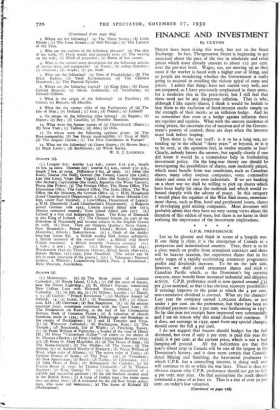C.P.R. PREFERENCE Let us be gloomy and think in terms
of a longish war. If one thing is clear, it is the emergence of Canada as a prosperous and industrialised country. True, there is to be a close watch on profits from armament contracts and there will be heavier taxation, but experience shows that in the early stages of a rapidly accelerating armament programme profits and dividends increase. To be on the safe side, however, we shall avoid armament shares and stick to Canadian Pacific which, as the Dominion's big carrying concern, must benefit from increased industrial and shipping activity. C.P.R. preference stock is now quoted around £33 per LI oo nominal, so that it has obvious recovery possibilities if earnings improve to the point at which the 4 per cent. non-cumulative dividend is covered. What are the chances? Last year the company earned 1,262,000 dollars, or just under I per cent. on the preference, but there has been no dividend payment since 2 per cent. was forthcoming in 1937. So far this year net receipts have improved very substantially and I see no reason why this trend should not continue. If it does, net earnings in 1939, apart from any special charges, should cover the full 4 per cent.
I do not suggest that buyers should budget for the full dividend, but even if only 2 per cent. is paid this year the yield is 6 per cent. at the current price, which is not a bad jumping-off ground. All the indications are that this year's wheat crop in Canada will be one of the largest in the Dominion's history, and it does seem certain that Consoli- dated Mining and Smelting, the base-metal producers in which C.P.R. has a controlling interest, is doing well and will continue to do so while the war lasts. There is thus no obvious reason why C.P.R. preference should not get its full 4 per cent. next year. On that assumption the stock should command a price of at least 5o. That is a rise of over 5o per cent. on today's low valuation.
(Continued on page 728)




































































 Previous page
Previous page